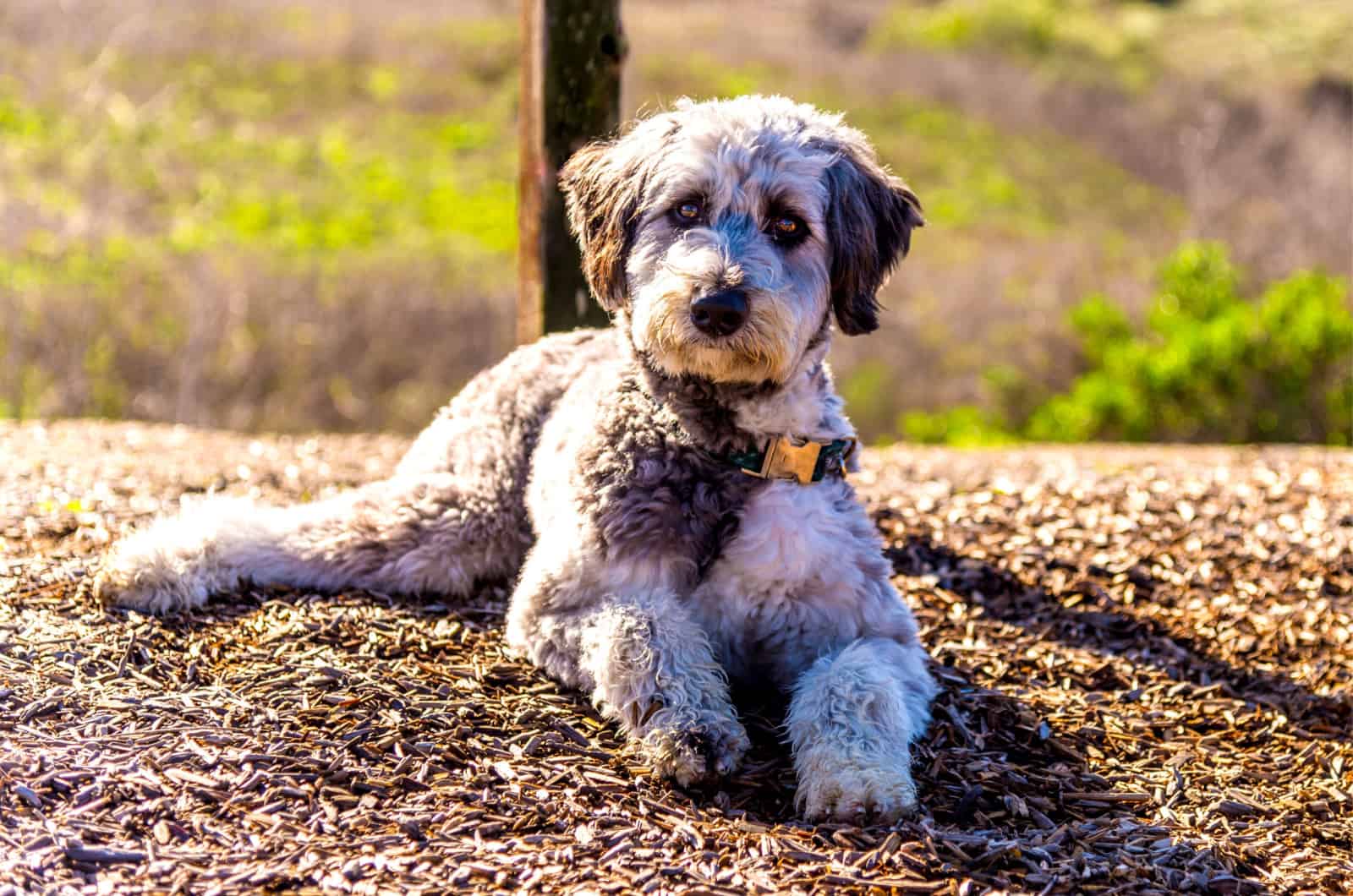Aussiedoodle puppies are some of the most adorable and family friendly dogs out there, but there are many variations of this precious mixed breed of dog and the names can get confused.
That’s why people often ask what’s the difference when comparing F1b Aussiedoodle vs F1 Aussiedoodle?
In the F1b Aussiedoodle vs F1 Aussiedoodle debate, people often get confused on this naming method.
Believe me you’re not the only one, but the difference here is that the F1 Aussiedoodle is a mix between a poodle and an Australian Shepherd whereas the F1b Aussiedoodle is a mix between an F1 Aussiedoodle and a poodle.
It’s still likely a bit confusing, but think of the F1b as the second generation mixed breed, an attempt to make an Aussiedoodle breed with 3 part poodle and 1 part Australian Shepherd.
Why, you may ask, why go through all the trouble? Well, the breed carries a few surprising differences compared to its predecessor, and the main goal when mixing the two breeds here was to get one that’s completely hypoallergenic.
The F1b ended up perfecting that through primarily poodle genes, plus they ended up getting a different temperament in said dog breed, one that was more family-oriented.
But, as with any other topic, this has created many a divide and discussion on whether the former is better than the latter, and that’s what we’re here to find out today.
So read on to find out what each of these fantastic mixed breeds brings to the table, what sets them apart and which one is ultimately better for you and your household.
You will also discover answers to some of the more frequently asked questions regarding said breeds.
F1b Aussiedoodle Vs F1 Aussiedoodle: The Rundown
Before we get to the comparisons, I’ll take both breeds in question and give you a brief rundown on both so you can see what makes each of them individually special and desirable.
We’ll start with the F1 Aussiedoodle first and then move down a generation to the F1b.
The F1 Aussiedoodle
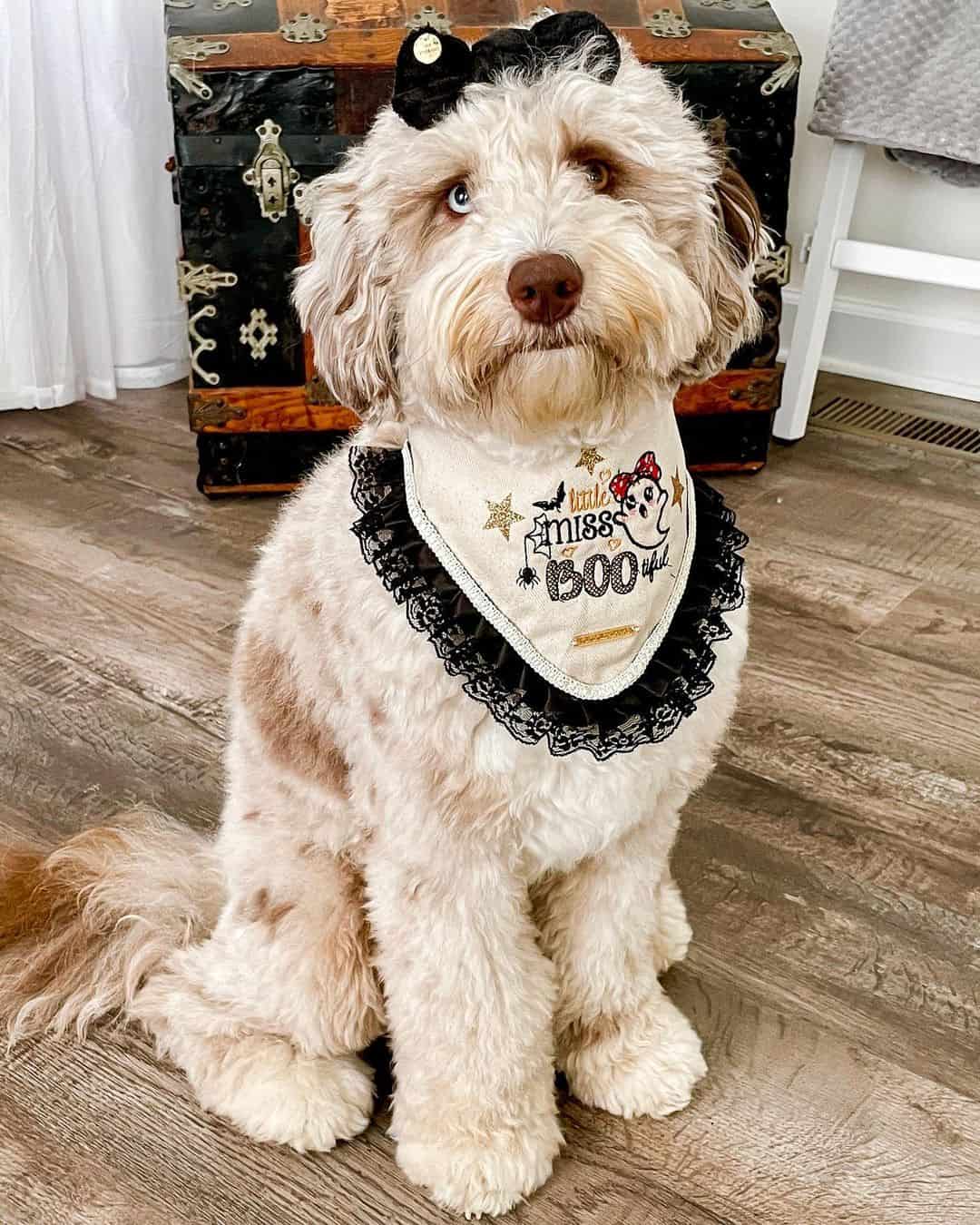
Photo from: @junie_b_and_eloise
The F1 Aussiedoodle, also known as the first generation Aussiedoodle, is a mix of a purebred Poodle and a purebred Australian shepherd.
The F1 is used to denote the generation in this context, so hopefully those weird number and letter combos make more sense now.
It’s the poster child for Aussiedoodles even though the different versions have distinct differences.
The F1 is more prevalent than the others though given it being the first in the series in a sense and how most of them originate from the breed in question.
The idea was to create the perfect household dog that doesn’t shed, wasn’t high maintenance and that was great with kids and families in general.
However, the genes weren’t exactly consistent with the desired results and the Aussiedoodle ones weren’t playing well with the Poodle ones, creating a large array of variance.
Sometimes you’d hit the jackpot with a curly-haired, hypoallergenic dog with low to non-shedding capabilities.
But, sometimes, you’d get a dog with straight, or even wavy hair which usually wasn’t the desired result which would only cause disappointment in the breeders.
Said hair would even shed heavily in some F1 Aussiedoodles and they wouldn’t be hypoallergenic at all.
It all depended on whether or not the Poodle genes were the dominant ones or not. If you’re someone who’s more at home with an idealized version of a dog, then the F1 Aussiedoodle may be a skip for you.
However, they’re not bad by any means.
In fact, the F1 Aussiedoodles have a trait called hybrid vigor, one that dictates that the first generation of a crossbreed will be healthier than any others down the line.
The reason why is because purebreds are known for having an abundance of genetic defects due to the fact that producing a purebred is equivalent to inbreeding or doggy incest.
The F1 Aussiedoodle on the other hand will end up only getting the more common health issues both parent breeds face while staying on the healthier side of the spectrum.
Temperament
The F1 Aussiedoodle is a pretty high energy dog, some may even classify him as hyperactive to a degree, or rather, one that doesn’t know its limits.
That’s why early socialization is often needed to properly prepare the F1 doodle for interacting with other dogs and children without going overboard.
That said, they’ll return your early efforts of love, training and affections back tenfold by becoming some of the best family dogs out there.
Though, given their high energy, they do need a lot of daily exercise through walks or play and providing him with a large play area is going to be the best solution for him.
They are, however, highly intelligent given its relation to the Australian Shepherd and will take to any training with relative ease.
Height And Weight
The F1 Aussiedoodle is considered a medium sized breed with height going from 10 inches to 15 or more depending on Aussiedoodle size, a.k.a. whether it’s a toy Aussiedoodle, mini Aussiedoodle or a standard one.
With this in mind, his weight can vary heavily, going anywhere from 10-16 lbs in toy Aussiedoodles all the way to the range of 45 to 70 lbs for standard Aussiedoodles.
RELATED: Aussiedoodle Growth Chart — How Big Do Aussiedoodles Get?
Coat Colors
As for the actual colors of an F1 Aussiedoodle, they’re the same as they would be in his parents.
You’re most likely to see 4 different variants: Phantom, Sable, Tuxedo and Merle, though there are also chances of getting white markings on your doggo at random spots which can give him a more unique feel.
RELATED: Aussiedoodle Colors – The Art Of Doodles
The Cost
However, despite all of these potential mishaps, the F1 Aussiedoodle is still a highly sought after mixed breed, reaching costs anywhere between $1500 all the way to a staggering $5000 depending on the breeder.
Shelters may have some, but it’s highly unlikely given the demand for this particular breed of dog, so do be ready to pay a premium if you’d like to own one.
This isn’t even taking maintenance costs into account which would add a lot more in there in terms of buying doggy gear, food and the like.
Health Issues And Lifespan
The standard F1 Aussiedoodle has a life expectancy of 12-15 years, pretty common for most doodle breeds, especially considering they don’t get any major health issues due to that hybrid vigor we’ve talked about earlier.
They can suffer from hip dysplasia which is always a risk for medium or large dog breeds, as well as issues regarding the eyes which is common for the standard poodle and any mixes involving them.
Finally, they’re also prone to a skin condition called sebaceous adenitis which, again, comes from its poodle parent more often than not.
The F1b Aussiedoodle
Next up in the F1b Aussiedoodle vs F1 Aussiedoodle competition, we have the other side of the coin, the next generation mixed breed to the F1 Aussiedoodle, the F1b.
Now, this one also has two different variants that fall under the same umbrella as it’s a breed variant made with an F1 Aussiedoodle as one parent and either a purebred Australian Shepherd or poodle as the other.
This is done in order to get something more closely resembling one of the first generation breeds, but with hints of the traits from the other.
That said, the choice is usually backcross breeding with the Poodle parent due to their more desirable, non-shedding and hypoallergenic qualities, but there are those who prefer to backcross with the Aussie instead.
If we’re going by the more popular, Poodle dominated option, you’ll find that the coat type now has a lot less chance to turn out straight, and that curly and wavy coats are the more prevalent options thanks to the higher percentage inclusion of the Poodle gene.
Though, while as playful as the F1 Aussiepoo and as eager to mingle with kids and other dogs, the F1b Aussiedoodle doesn’t possess that hybrid vigor that the F1 does, at least, not as potent of one, making them more prone to certain health issues.
Temperament
Much like the F1, the F1b Aussiedoodle is an intelligent breed, always looking for some sort of mental stimulation to earn that personal satisfaction for the day.
They’re pretty high in energy too, always eager to play or just jump around like crazy.
You’ll need room and the tools to facilitate both of these aspects, otherwise, you may run into some trouble as your F1b starts trying to get your attention through more destructive means.
They are little primadonnas who won’t shy away from going through your slippers or your couch if they’re left without the attention they need.
Of course, all of this can be remedied with proper training and by reciprocating said affection.
In all honesty, it’s not that much more than a standard dog would need anyway.
Hypoallergenic
The main reason breeders went further than the F1 and over to the F1b is to get a more consistently hypoallergenic and non-shedding dog, which they’ve succeeded in creating.
However, that doesn’t mean that your hair worries are over.
When cleaning up hair after your dog goes away, grooming takes its place, and these dogs will need to go to the groomers often, every few weeks, in order to get their fur trimmed down so they don’t look too shaggy or get mats and knots.
Height And Weight
The Poodle F1b has slightly lower proportions than its F1 parent, clocking in at around 15 to 25 inches in height maximum.
Weight wise, they reach about 35 to 50 pounds in total between all variants.
This makes them a delightful medium breed dog, smaller than the F1, but equally as lovable, if not more.
Coat Color
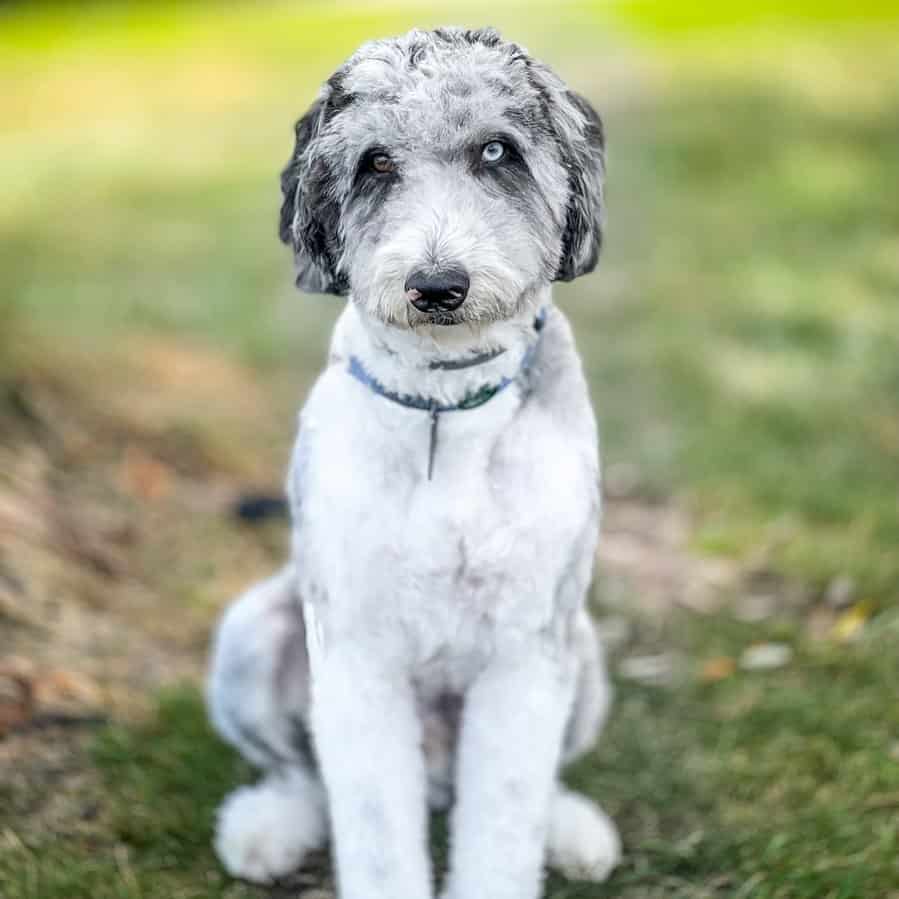
Photo from: @westpenndoodles
The F1b Aussiedoodle is more likely to receive the coat colors of its Poodle parent than the F1 Aussiedoodle, though they’re mostly similar.
The most common ones that you can expect are Blue Merle, blue merle phantom, red merle and brown merle, all of them presented in delightful color patterns that are as vibrant as the F1b’s playful nature.
Cost
Being the more preferred non-shedding version of the Aussiedoodle and taking more effort to produce one, the F1b comes out as a lot pricier than its parent, with prices ranging from $2400 to a staggering $10000, depending on where you buy them from.
The average comes out to somewhere below $4000, but it’s still a hefty price to pay for a canine companion.
Once again, it’s worth noting that this is just the initial purchase price for the dog itself, there are still other bits of dog gear that you’ll need to buy, be it dog food, toys, leashes, collars, and any other items or services pertaining to them.
It all comes out as much more expensive than previously thought which can bore a serious hole through your wallet
Health Issues And Lifespan
The weakened hybrid vigor of the F1b Aussiedoodle means that they have a wider lifespan range, most of them falling under the 10-15 year mark.
They’re also more prone to the same health issues that their dominant side can have, in the more popular, Poodle parent dominant side, that’d be the eye-related diseases like retinal degradation and similar as well as the sebaceous adenitis skin condition.
If, however, you’ve gone for the Australian Shepherd parent dominant one, your worries will relate to Cushing’s disease, glaucoma and pancreatitis more than anything.
Sadly, no dog is immune to health issues, the later generations of crossbreeds even less so, though they’re still somewhat healthier than their parent breeds.
F1b Aussiedoodle Vs F1 Aussiedoodle: The Comparison
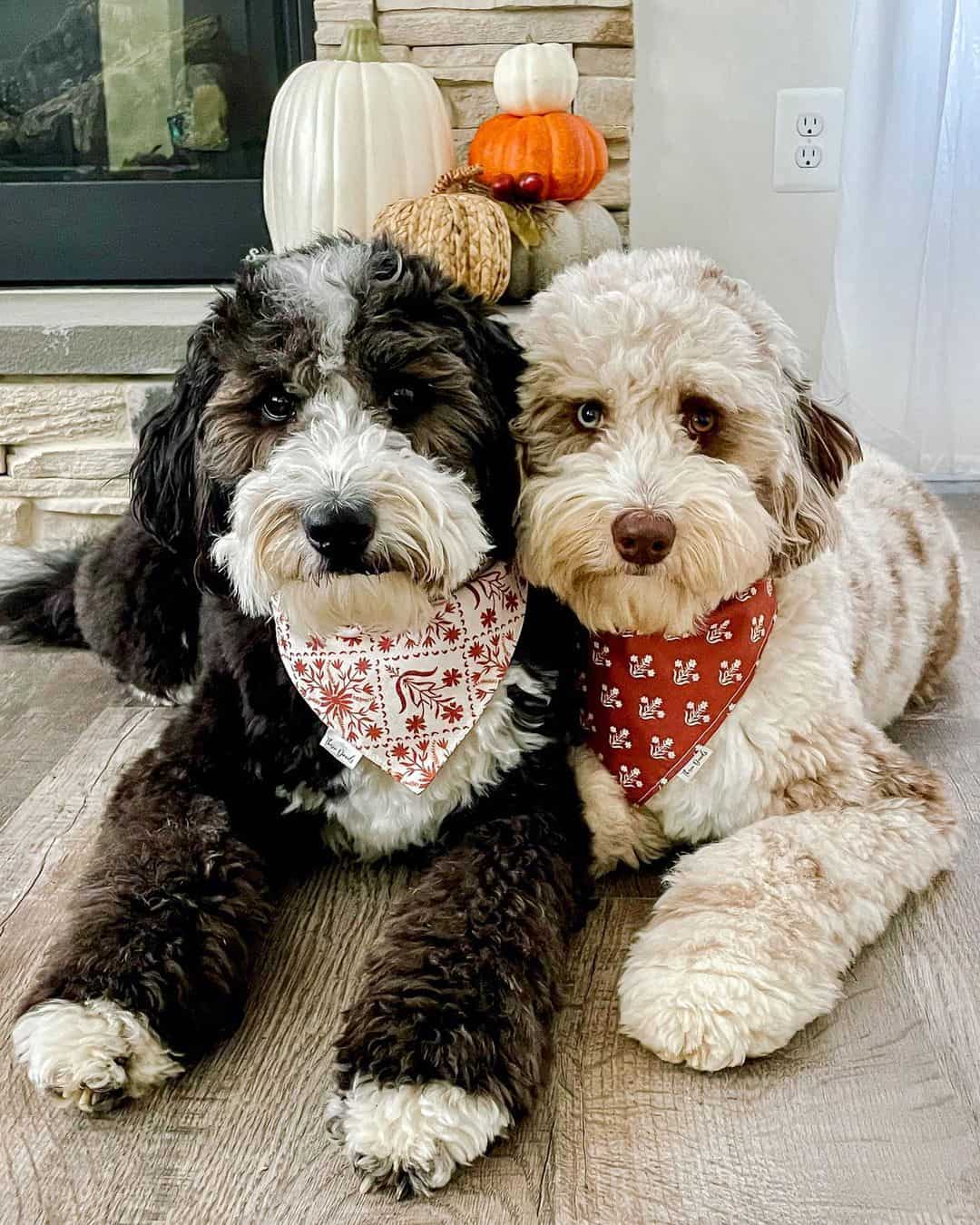
Photo from: @junie_b_and_eloise
So, now that we have the two Aussiedoodle variants listed, it’s time to compare them to see which one of them is the better of the two.
Temperament: A tie
While the F1b Aussiedoodle may be a little bit more stuck up than the F1 Aussie, ultimately, they behave mostly the same.
They’re both highly intelligent and high energy, needing about equal amounts of attention.
After all, they’re pretty similar in many aspects given their closeness.
Hypoallergenic: The F1b Aussiedoodle Wins
This one is an obvious win given how the F1b is non-shedding and hypoallergenic by default whereas it’s a gamble whether or not the F1 Aussiedoodle will even get the right coat for him to be classified as such.
Coat Color: Subjective
Not really a significant metric for most people, but for those who value the aesthetic greatly, this is a matter of personal opinion, some may like the hues that the F1 Aussiedoodle gets while others may like the F1b’s color options
Overall Health: The F1 Aussiedoodle Wins
The F1 has that potent hybrid vigor going for it, and, while the F1b does too, it’s to a significantly lesser extent than the former making him more prone to various diseases and health issues.
It also makes him live less on average which is always a saddening fact.
Maintenance Costs: The F1 Aussiedoodle Wins
Not only is the F1 Aussiedoodle cheaper to get by a significantly large margin on average, they’re also a bit easier to maintain.
Sure, the F1b doesn’t shed and is hypoallergenic, but the frequent need for grooming will rack up the price while the regular F1 Aussiedoodle won’t need it as much as his competitor here.
F1b Aussiedoodle Vs F1 Aussiedoodle: The Winner
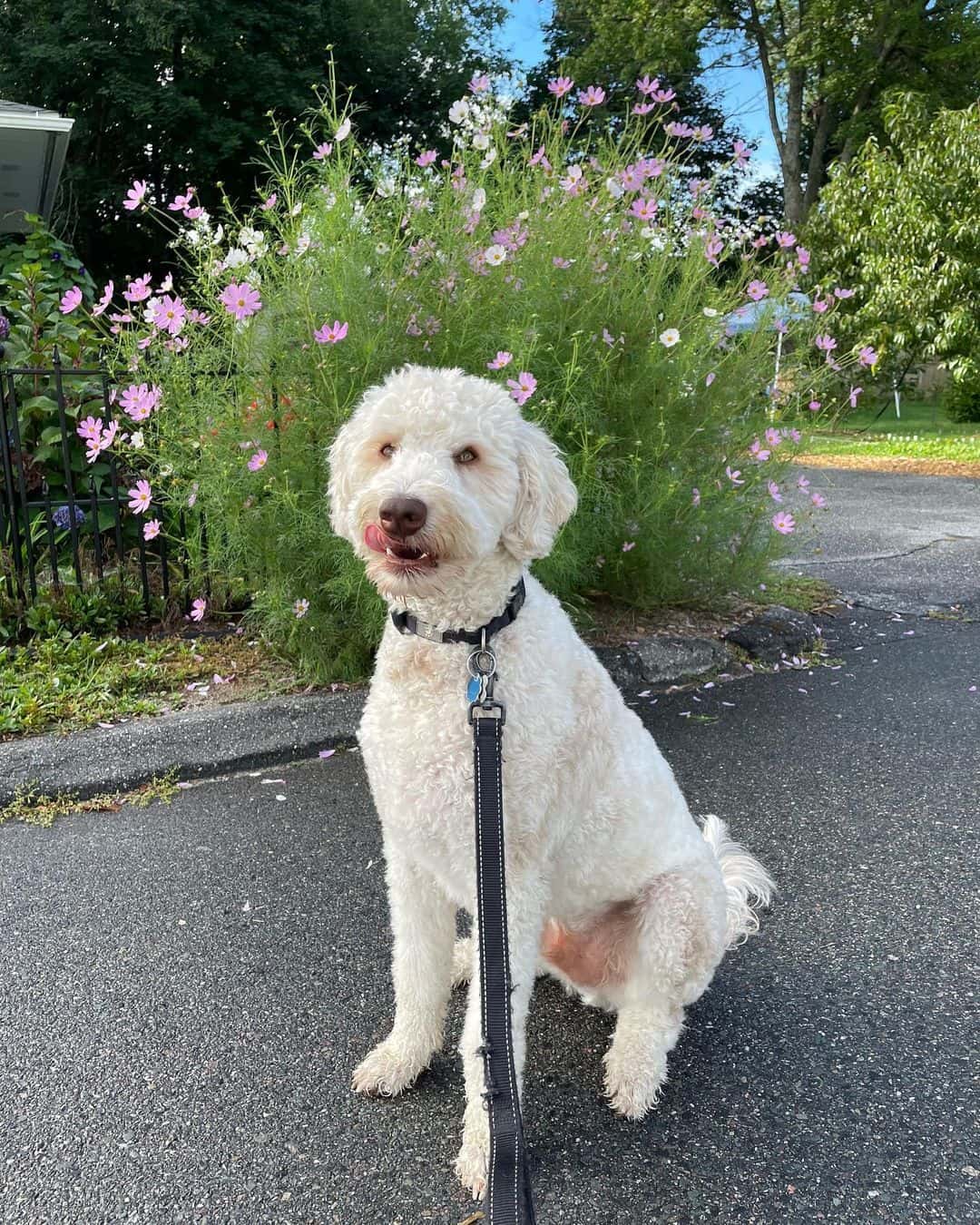
With everything in mind, the winner here depends on whether you value budget more than the hypoallergenic trait.
If it’s the former and you’re mostly looking for an Aussiedoodle for his looks, then the F1 Aussiedoodle is the winner of this contest and the right option for your homestead.
If, however, your main goal of getting an Aussiedoodle was to find one that doesn’t shed and money is less important than your families’ pet allergies, then the F1b Aussiedoodle would be the proper winner here.
As always, that one is up to you to decide, I’m only here to state the facts and drop some of my own bias here and there.
Feel free to analyze the facts given and draw your own conclusions from it. Maybe you spot something that makes one more appealing to you than the other.
FAQs
What Does The Letter F Stand For In These Aussiedoodle Generation Markers?
The F in the Aussiedoodle, and many other crossbreeds, stands for a Filial hybrid.
While the name may be technical, it’s essentially a fancy way to say a hybrid dog which is used to mark any crossbred.
What About The Number?
The number after the F indicates which generation the dog belongs to. In the case of our two competitors here, they were both first generation hybrid dogs of their kind.
And The “B”?
The B in the F1b indicates that the dog is a Backcross of another crossbreed.
To put it in simpler terms, it means that that specific hybrid dog came out as a result of a crossbreed and a purebred parent of that crossbreeding mating and producing an offspring.
Are There Any Other Aussiedoodle Generations Besides The F1 And The F1b?
Of course there are, breeders tend to experiment a lot to get a dog to possess ideal traits, both physical and mental, so these two aren’t the only ones in existence.
Aside from those, you have:
• The F1BB Aussiedoodle which is a backcross of the F1b with a Poodle
• The F2 Aussiedoodle, a second generation Aussiedoodle which is crossbreed of two F1 Aussiedoodles
• The F2B Aussiedoodle, a backcross of the F2 Aussiedoodle and a Poodle or Australian Shepherd respectively
• The F2BB Aussiedoodle, the backcross of the F2B backcross together with a poodle
• F3 Aussiedoodle, considered to be a multi-generation Aussiedoodle made throughout several generations of Aussiedoodle breeding.
Why Do People Go That Far Down The Generational Line?
Well, again, it’s mostly to try and get those desirable traits on lock through mixing and matching, however, the further down they go, the more unpredictable the results get.
The F1b doodle is generally about as stable as it gets while still retaining some of that hybrid vigor, whereas second generation and multigen Aussiedoodles tend to be more trouble than they’re worth with how prone they are to certain health issues.
In the case of the Aussiedoodle specifically, they’re trying to get a low-shedding or no-shedding variant on lock to provide an option for people with mild allergies or even severe allergies to pet hair.
Are There Any Other Poodle Crossbreeds?
Of course there are. The Poodle is one of the most popular purebred dogs for breeders to make hybrid dogs with given their wonderful positive traits that are highly valued in dog owners.
Everyone wants a hypoallergenic, smart, lovable and high energy dog, but they want different aesthetics, so the supply needs to meet the demand.
Some of the most popular hybrids with Poodles are:
• The Goldendoodle, a mix of Poodle and Golden Retriever
• The Labradoodle, a mix of Poodle and Labrador Retriever
• The Sheepadoodle, a mix of Poodle and Old English Sheepdog
• The Bernedoodle, a Bernese Mountain Dog and Poodle mix
How Long Do Aussiedoodles Live For?
It depends on which generation it is and whether or not it was a backcross.
Usually, the F1 cross breeds live the longest, in the Aussiedoodles’ case, they tend to live upward to around 15.
The further down the line you go, the lower the life expectancy is with the average ending up around 10 to 13 years of age.
It may sound like too little, but most dogs in general make it to around 12 to 15 years, one of the saddest drawbacks of such a loving and playful creature like the dog.
Why Even Bother With Hybrids?
Well, as I’ve previously mentioned, people want the traits of one dog breed with the aesthetic of another.
That is the primary reason why crossbreeding happens in the first place.
It’s that whole search for the ideal designer dog with the perfect traits that cater to every dog owner.
This is usually time-consuming and pretty luck-based, which is why the existing cross breeds and their generations are as expensive as they are.
Would You Recommend Any Of The Other Generations Other Than The F1s?
It depends on how specific you want your dog’s traits to be. The further down you go, the more expensive it gets, but the results also keep getting more unpredictable and their hybrid vigor dissipates.
I’d say that F2 would be the limit as to how far I’d recommend going down in, if you have the money that is, otherwise, I’d stick to F1s since they’re pretty much already perfected enough and still have good health habits for the most part.
In Conclusion
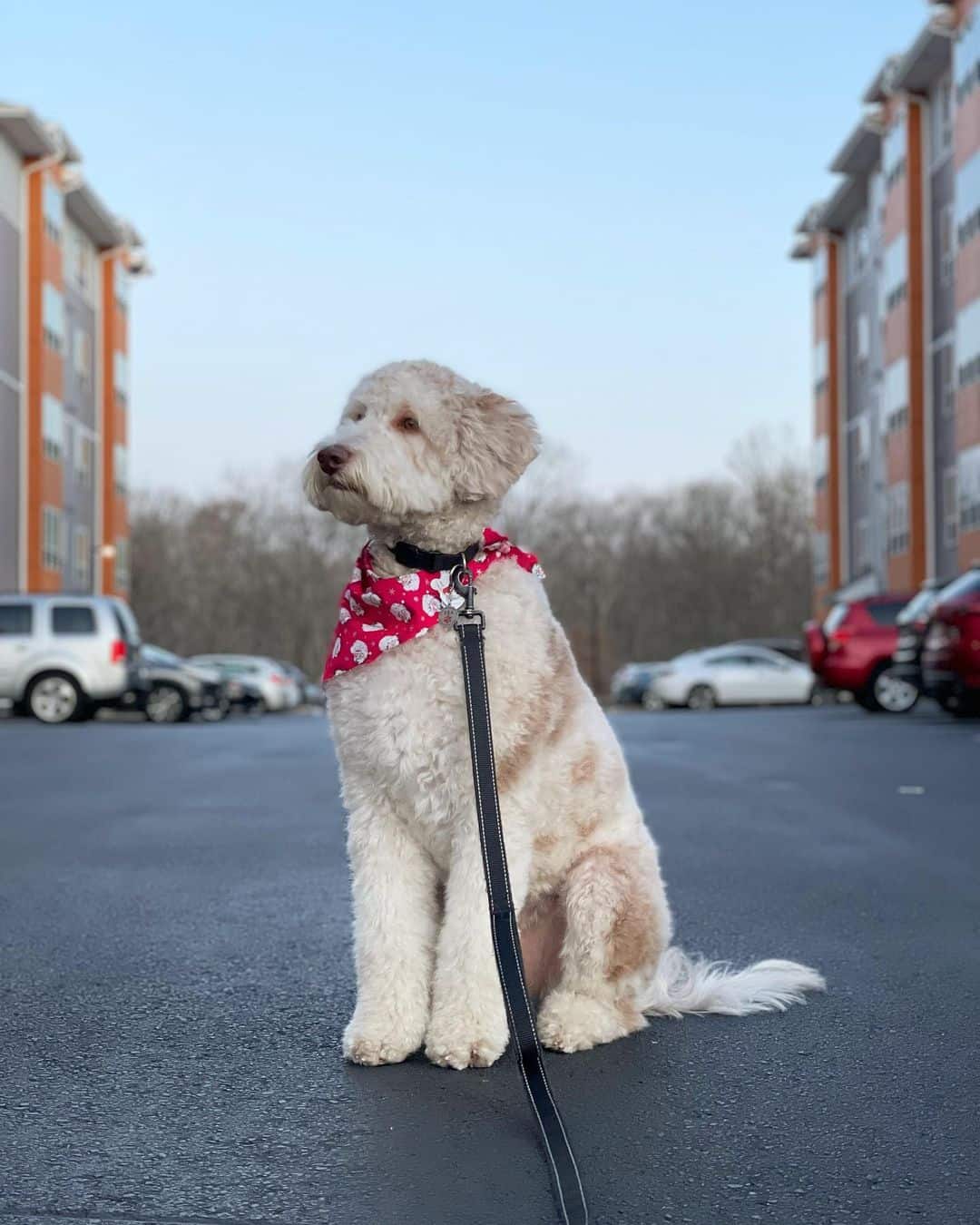
Photo from: @leo.theaussiedoodle
The F1b Aussiedoodle vs F1 Aussiedoodle debate comes to a real close finish, one that’s decided by two key factors, cost and utility, and aesthetic as a third, lesser one.
The F1b has the advantage of being a low to no shedding, hypoallergenic hybrid dog with an aesthetic more befitting to that of a Poodle for the most part.
It was the intended goal of the breeders in the first place and likely the dog owners who are looking to own a dog without having to deal with severe allergies.
However, it does come at an almost prohibitive cost for the average person.
The F1 on the other hand, carries the aesthetic of an expected mix between the two purebred parents, however, getting them to be hypoallergenic and low-shedding completely hedges on the way the Aussiedoodle’s coat turns out.
If it’s a wavy or a curly coat, you’re good, but if it ends up straight, you’re going to have to deal with a lot of shedding regardless.
Their aesthetic is more pinpointed given their genes, and they’re a lot cheaper than the F1b since it takes less effort to breed one.
They also have something that’s called hybrid vigor, a trait that makes them less prone to health issues that their purebred parents possess while avoiding some of the other uncommon health issues.
This also lends them to a slightly longer lifespan than the former.
The 2nd generation and onward are also a consideration, but can’t really compare that well to the F1s, in my opinion.
Regardless of the differences, both are fantastic choices in their own right. I fully believe that you’ll be able to make the right one for you and your family when the time comes. Until next time.
RELATED LINKS:
• Aussiedoodle Growth Chart — How Big Do Aussiedoodles Get?
• About The Golden Aussiedoodle: Everything You Wish To Know
